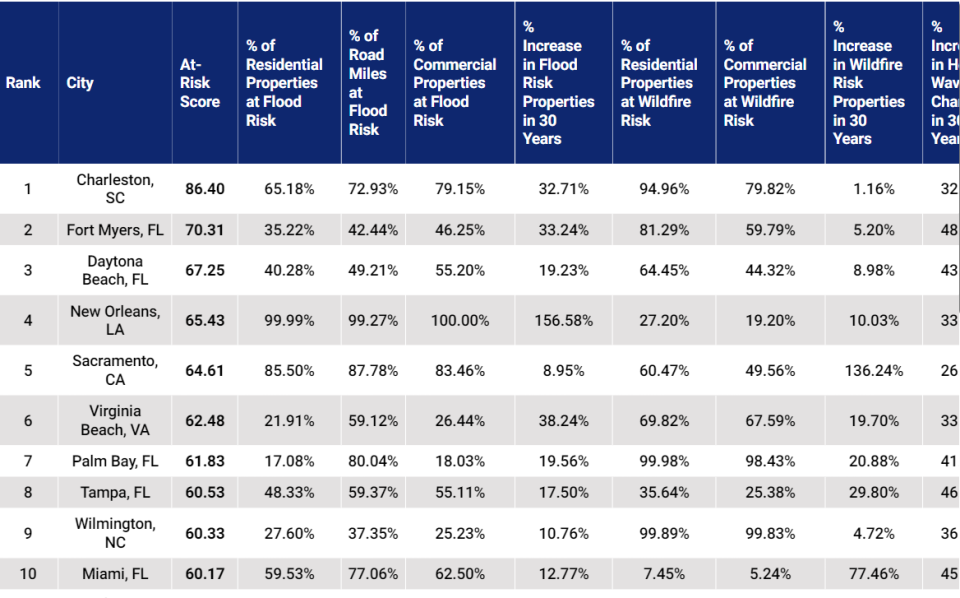Risk report: Fort Myers No. 2 spot in the nation for flood, fire, heat and wind damage
Florida is home to five of the 10 most dangerous cities in the nation when it comes to flood, fire, wind and heat risks.
Riskfactor.com recently compiled the list, which has Fort Myers in the No. 2 spot, behind only Charleston, S.C.
The report ranks the 100 most populated cities and gave them a rating for fire, flood, heat and wind damage potential, and by how much those risks are expected to increase over the next 30 years.
Despite it's high ranking, flood risk for Fort Myers was lower than some neighboring cities. Cape Coral and Naples were not in the top 10 but showed significant flood risks. Naples has 6,698 properties with greater than a 26% chance of being severely affected by flooding over the next 30 years, the report said. That represents 98% of all properties in Naples.
Cape Coral has 90,835 properties with a greater than a 26% chance of being severely affected by flooding over the next 30 years. That represents 84% of all properties in Cape Coral.

Hurricane Ian moved giant yacht: 10 photos tell the story of behemoth boat stuck in time near Fort Myers Beach
RiskFactor.com, a free tool created by the nonprofit First Street Foundation, provides industry information for banks and insurance companies in hopes of helping them make better financial decisions with regards to climate change and an uncertain future. They then gave a range of scores for each risk and added up the results.
What's so dangerous about Fort Myers?
Well, apparently a lot.
A look at disaster risks
The study says more than 35% of residential homes and 42% of roads are in danger of flooding.
"Deeper floods from major events, like hurricanes, are less likely to occur, but affect more properties than more shallow flood events, like heavy rains," RiskFactor says. "As Fort Myers feels the effects of a changing environment, however, events of all kinds will affect more properties within the community."
The number of properties exposed to flood risks is expected to rise 33%, the study says.
Wind speeds expected to increase
Maximum wind speeds during major storms is expected to go up by 16 miles per hour over the next 30 years, the study says.
That type of increase in winds would take a Category 2 hurricane to a Category 3 storm, from extremely dangerous to devastating damage.
Heat waves are going to be more common
The report says the chances of Fort Myers seeing a heat wave will go up by 48% over the next three decades. Fort Myers claimed the No. 2 spot in that category.
The National Weather Service defines a heat wave as a period of abnormally hot conditions lasting more than two days.
"A hot day in Fort Myers is considered to be any day above a 'feels like' temperature of 107ºF. Fort Myers is expected to experience 7 hot days this year," the report says. "Due to a changing climate, Fort Myers will experience 30 days above 107ºF in 30 years.
Wildfire risks on the rise
Fort Myers scored very high (81%) in the percentage of residents who will be more at risk of a wildfires in the future.
Palm Bay lead the way, though, scoring 99.9% in the same category.
The wildfire season here tends to coincide with the late dry season and the early rainy summer months, when lightning can strike and hit dry vegetation.
More: Lake O is high at the start of hurricane season, and why that matters
More: Look out: It's manatee mating season; also some wild myths and facts
More: Field notes: Is the ivory-billed woodpecker really extinct?; plus new snook rules
Risks go down as the summer goes on, and as more rain soaks into the landscape.
Fort Myers was part of a moderate drought earlier this year, according to the National Oceanic and Atmospheric Administration, or NOAA.
Several Florida cities considered dangerous
Other Florida cities ranked in the top 10 include: Daytona Beach (No. 3), Palm Bay (7), Tampa Bay (8), and Miami (10).
The report says making informed decisions on future financial risks is crucial for the businesses it supports.
How can we prepare for a changing climate and weather conditions?
"Lowering flood risk starts with higher standards," the report reads. "Some places plan to a higher standard (a “500-year” standard) that lowers the number of properties at severe risk. Protecting homes to this level would reduce the risk to the 5,489 severely affected properties."
Connect with this reporter: Chad Gillis on Facebook.
This article originally appeared on Fort Myers News-Press: Risk analysis ranks Fort Myers as second most dangerous city in U.S.

